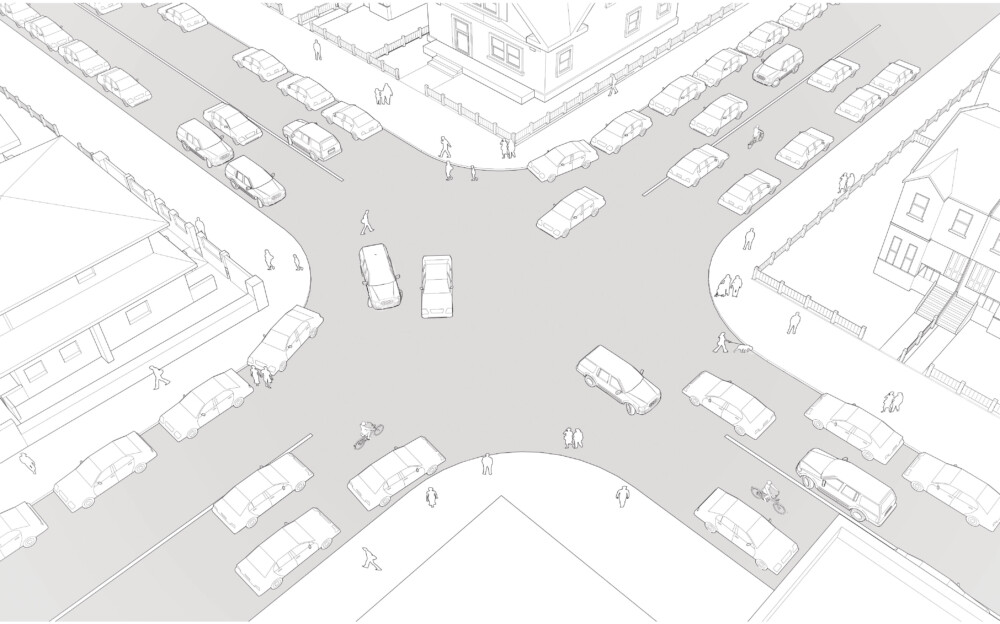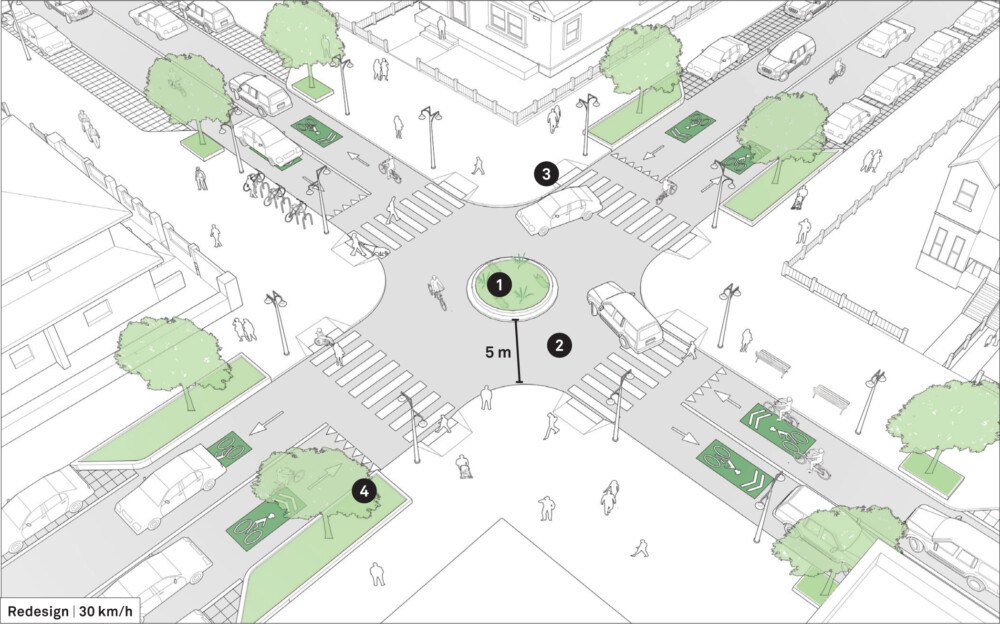-
About Streets
- Introduction
- Defining Streets
-
Shaping Streets
- The Process of Shaping Streets
- Aligning with City and Regional Agendas
- Involving the Right Stakeholders
- Setting a Project Vision
- Communication and Engagement
- Costs and Budgets
- Phasing and Interim Strategies
- Coordination and Project Management
- Implementation and Materials
- Management
- Maintenance
- Institutionalizing Change
- Measuring and Evaluating Streets
-
Street Design Guidance
- Designing Streets for Great Cities
- Designing Streets for Place
-
Designing Streets for People
- Utilities and Infrastructure
- Operational and Management Strategies
- Design Controls
-
Street Transformations
- Streets
-
Intersections
- Intersection Design Strategies
- Intersection Analysis
- Intersection Redesign
- Mini Roundabout
- Small Raised Intersection
- Neighborhood Gateway Intersection
- Intersection of Two-Way and One-Way Streets
- Major Intersection: Reclaiming the Corners
- Major Intersection: Squaring the Circle
- Major Intersection: Cycle Protection
- Complex Intersection: Adding Public Plazas
- Complex Intersection: Improving Traffic Circles
- Complex Intersection: Increasing Permeability
- Resources
Global Street Design Guide
-
About Streets
- Introduction
- Defining Streets
-
Shaping Streets
Back Shaping Streets
- The Process of Shaping Streets
- Aligning with City and Regional Agendas
- Involving the Right Stakeholders
- Setting a Project Vision
- Communication and Engagement
- Costs and Budgets
- Phasing and Interim Strategies
- Coordination and Project Management
- Implementation and Materials
- Management
- Maintenance
- Institutionalizing Change
-
Measuring and Evaluating Streets
Back Measuring and Evaluating Streets
-
Street Design Guidance
-
Designing Streets for Great Cities
Back Designing Streets for Great Cities
-
Designing Streets for Place
Back Designing Streets for Place
-
Designing Streets for People
Back Designing Streets for People
- Comparing Street Users
- A Variety of Street Users
-
Designing for Pedestrians
Back Designing for Pedestrians
- Designing for Cyclists
-
Designing for Transit Riders
Back Designing for Transit Riders
- Overview
- Transit Networks
- Transit Toolbox
-
Transit Facilities
Back Transit Facilities
-
Transit Stops
Back Transit Stops
-
Additional Guidance
Back Additional Guidance
-
Designing for Motorists
Back Designing for Motorists
-
Designing for Freight and Service Operators
Back Designing for Freight and Service Operators
-
Designing for People Doing Business
Back Designing for People Doing Business
-
Utilities and Infrastructure
Back Utilities and Infrastructure
- Utilities
-
Green Infrastructure and Stormwater Management
Back Green Infrastructure and Stormwater Management
-
Lighting and Technology
Back Lighting and Technology
-
Operational and Management Strategies
Back Operational and Management Strategies
- Design Controls
-
Street Transformations
-
Streets
Back Streets
- Street Design Strategies
- Street Typologies
-
Pedestrian-Priority Spaces
Back Pedestrian-Priority Spaces
-
Pedestrian-Only Streets
Back Pedestrian-Only Streets
-
Laneways and Alleys
Back Laneways and Alleys
- Parklets
-
Pedestrian Plazas
Back Pedestrian Plazas
-
Pedestrian-Only Streets
-
Shared Streets
Back Shared Streets
-
Commercial Shared Streets
Back Commercial Shared Streets
-
Residential Shared Streets
Back Residential Shared Streets
-
Commercial Shared Streets
-
Neighborhood Streets
Back Neighborhood Streets
-
Residential Streets
Back Residential Streets
-
Neighborhood Main Streets
Back Neighborhood Main Streets
-
Residential Streets
-
Avenues and Boulevards
Back Avenues and Boulevards
-
Central One-Way Streets
Back Central One-Way Streets
-
Central Two-Way Streets
Back Central Two-Way Streets
- Transit Streets
-
Large Streets with Transit
Back Large Streets with Transit
- Grand Streets
-
Central One-Way Streets
-
Special Conditions
Back Special Conditions
-
Elevated Structure Improvement
Back Elevated Structure Improvement
-
Elevated Structure Removal
Back Elevated Structure Removal
-
Streets to Streams
Back Streets to Streams
-
Temporary Street Closures
Back Temporary Street Closures
-
Post-Industrial Revitalization
Back Post-Industrial Revitalization
-
Waterfront and Parkside Streets
Back Waterfront and Parkside Streets
-
Historic Streets
Back Historic Streets
-
Elevated Structure Improvement
-
Streets in Informal Areas
Back Streets in Informal Areas
-
Intersections
Back Intersections
- Intersection Design Strategies
- Intersection Analysis
- Intersection Redesign
- Mini Roundabout
- Small Raised Intersection
- Neighborhood Gateway Intersection
- Intersection of Two-Way and One-Way Streets
- Major Intersection: Reclaiming the Corners
- Major Intersection: Squaring the Circle
- Major Intersection: Cycle Protection
- Complex Intersection: Adding Public Plazas
- Complex Intersection: Improving Traffic Circles
- Complex Intersection: Increasing Permeability
- Resources
- Guides & Publications
- Global Street Design Guide
- Intersections
- Mini Roundabout
Mini Roundabout
Minor intersections in neighborhood contexts where small-scale residential streets meet each other should reinforce vehicles traveling at low speeds. These intersections should be redesigned to invite safe use and easy crossing for all users, including children walking to school and senior residents living their daily routines.


Existing Conditions
The illustration above depicts an intersection of two one-way streets, each with two travel lanes. The allocation of space in this intersection is unbalanced as these streets have very low traffic volumes but vehicles have most of the space. Parking is unregulated and vehicles are parked near the intersection corners.
Large corner radii create a dangerous condition due to vehicles turning at high speeds and conflicting with pedestrian movement.
A lack of marking at the intersection creates uncertainty about the space dedicated to each user.

Bandung, Indonesia.
Design Guidance
Mini roundabouts are an ideal treatment for unsignalized intersections of small-scale streets. They have been shown to increase safety at intersections, reducing vehicle speeds and minimizing the points of conflict.
In this type of intersection, motorists must yield to pedestrians and vehicles already in the intersection. Pedestrian crossings should be marked to clarify where pedestrians should cross and that they have priority.
![]() Install mini roundabouts using simple markings or raised islands. Apply them in conjunction with plantings or small trees, which enhance the traffic calming effect and beautify the street.
Install mini roundabouts using simple markings or raised islands. Apply them in conjunction with plantings or small trees, which enhance the traffic calming effect and beautify the street.
![]() Provide a clearance of approximately 5 m from the corner to the widest point in the roundabout. A clearance of less than 5 m is possible by providing mountable curbs on the edge of the roundabout.
Provide a clearance of approximately 5 m from the corner to the widest point in the roundabout. A clearance of less than 5 m is possible by providing mountable curbs on the edge of the roundabout.
When pedestrian volumes are high, consider raised crosswalks to further reduce vehicle speeds.
![]() Add curb extensions to shorten the crossing distance, protect pedestrians waiting to cross, daylight the intersection, and prevent dangerous illegal parking close to the intersection corners.
Add curb extensions to shorten the crossing distance, protect pedestrians waiting to cross, daylight the intersection, and prevent dangerous illegal parking close to the intersection corners.
![]() Plant trees, and add bioswales and rain gardens on curb extensions and widened sidewalks.
Plant trees, and add bioswales and rain gardens on curb extensions and widened sidewalks.

Austin, USA. A mountable curb in a neighborhood roundabout allows larger vehicles to navigate the intersection when required, while calming everyday traffic.
Adapted by Global Street Design Guide published by Island Press.
Next Section —